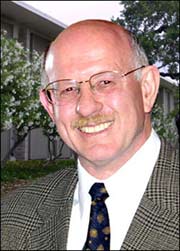
Handy Links
SLAC News Center
SLAC Today
- Subscribe
- Archives: Feb 2006-May 20, 2011
- Archives: May 23, 2011 and later
- Submit Feedback or Story Ideas
- About SLAC Today
SLAC News
Lab News
- Interactions
- Lightsources.org
- ILC NewsLine
- Int'l Science Grid This Week
- Fermilab Today
- Berkeley Lab News
- @brookhaven TODAY
- DOE Pulse
- CERN Courier
- DESY inForm
- US / LHC
SLAC Links
- Emergency
- Safety
- Policy Repository
- Site Entry Form

- Site Maps
- M & O Review
- Computing Status & Calendar
- SLAC Colloquium
- SLACspeak
- SLACspace
- SLAC Logo
- Café Menu
- Flea Market
- Web E-mail
- Marguerite Shuttle
- Discount Commuter Passes
-
Award Reporting Form
- SPIRES
- SciDoc
- Activity Groups
- Library
Stanford
Around the Bay
Dorfan Today: Keeping SLAC Green
 SLAC's home in the hills of northern California is a place of exceptional natural beauty, one to be cherished and nurtured. SLAC employees share a deep commitment to the health of the environment in general, and to that of SLAC in particular. I am pleased to express my appreciation for and share with you some of our recent achievements to protect the beauty and health of the local environment.
SLAC's home in the hills of northern California is a place of exceptional natural beauty, one to be cherished and nurtured. SLAC employees share a deep commitment to the health of the environment in general, and to that of SLAC in particular. I am pleased to express my appreciation for and share with you some of our recent achievements to protect the beauty and health of the local environment.
Several years ago, well in advance of the start of construction of the Linac Coherent Light Source (LCLS), SLAC established a waste management program for the civil construction phase of the project. One of the program's original goals was to divert 66% of the construction waste items such as paper, cardboard, wood, garden waste, scrap metals, and construction materials from being sent to landfills. Subsequent subcontractor estimates suggested that perhaps as much as 74% could be recycled or otherwise kept out of landfills.
I am happy to report that as of the end of March, according to actual debris calculations, both estimates have been exceeded. Since the start of construction last November, 66 tons of construction waste have been generated, of which 60 tons were diverted to be recycled. That is a success rate of more than 90%.
This is not our only environmental success story. Two weeks ago, Acting DOE Site Office Manager Aundra Richards presented the lab with a "Best in Class" award for pollution prevention on behalf of the Office of Science. The award recognizes SLAC's dedication to environmentally friendly practices as embodied by the lab's chemical management system (CMS). The CMS program takes a lifecycle approach to chemical management that includes how a chemical is purchased, stored, used and finally disposed of. SLAC can track chemical use, cost, inventory, safety data sheets, and order status. The ultimate goal is to reduce waste, minimize cost, and add value, while ensuring the safe handling and management of the chemicals we need.
SLAC's Environmental Management System also includes the Environmental Management Programs (EMPs). Each year the Environmental Safety Committee identifies programs with significant environmental aspects. The Environmental Safety Committee then works with the respective program managers to develop EMPs for each significant aspect. We have 13 EMPs for this fiscal year that cover areas including conserving water and energy, improving air quality, eliminating groundwater and soil contamination, minimizing waste, monitoring storm water and industrial wastewater, and carefully managing chemical storage, radioactive wastes, and nonradioactive wastes.
Thanks to all who work so conscientiously to make sure that the wonderful environment at SLAC is respected. Both on an individual and a personal level, we must continue to do all we can to maintain the environmental health of our precious site. Enjoy this beautiful spring!
—Jonathan Dorfan, April 30, 2007